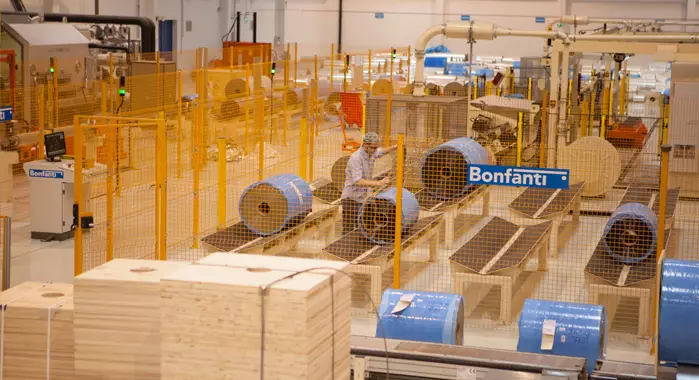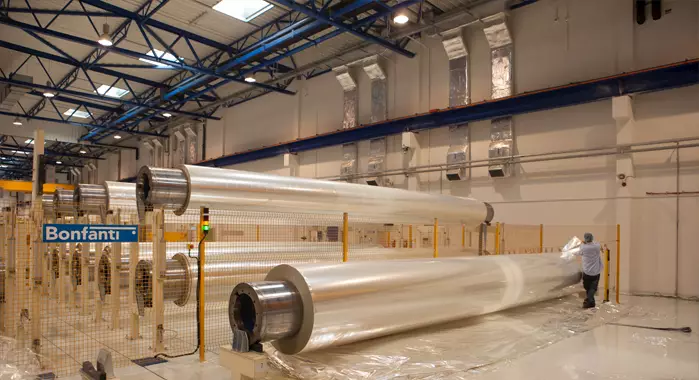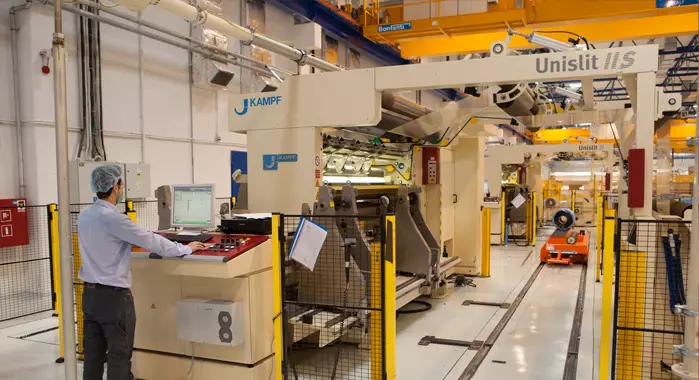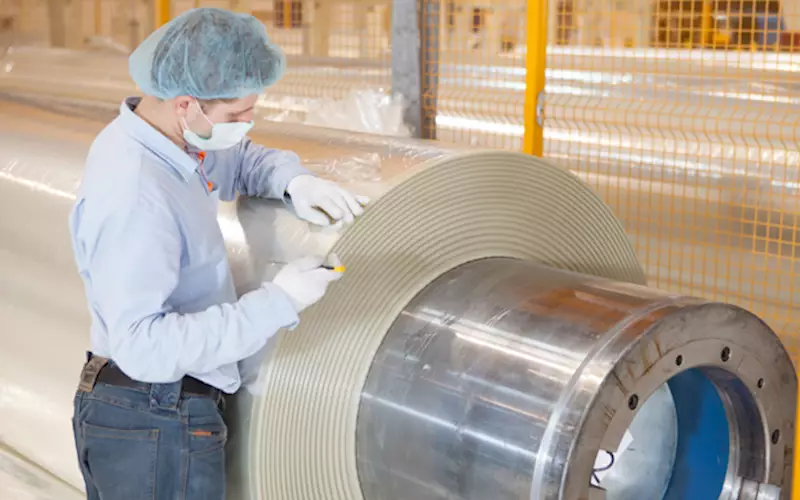Flex Films Europa, Uflex’s European stronghold
Września, a sleepy Polish town is the place from where Noida-based Uflex has set out to conquer the European flexible packaging market, and has been doing it magnificently. Rahul Kumar reports from the ground.
08 Dec 2017 | By Rahul Kumar
Headquartered in Noida, Uflex, the world’s leading supplier of BOPET, BOPP, CPP, Metalized and Speciality films for flexible packaging applications has polymeric film manufacturing facilities in India, Dubai, Mexico, Poland, Egypt and USA with a cumulative capacity more than 337,000 tpa/ year.
The Poland plant is in the sleepy small town of Września, halfway between the polish capital of Warsaw and the German capital Berlin. It’s a small place even by European standards but for it employees largely from the local populace and a few from India, Uflex offers all the amenities that are required for a progressive multinational organization. Września town has only a few restaurants but one among them also offers Punjabi cuisine!

The total area of the film production plant is 6.5 ha with facilities to run two production lines. Currently, it has a single 8.7 m wide high performance BOPET film manufacturing line with plans afoot for the second production line. The current line runs at the speed of 500m per minute.
The construction of the plant started in June 2011, and production commenced from July 2012. As Sundeep Saksena, head of Flex Europa, who joined the company in February, 2011 proudly says “The project was completed within 13 months, scratch to finish.” Saksena, an M.Tech from IIT Mumbai, and an MBA, has had successful stints in companies of repute like Good year, Blow Plast , Eureka Forbes, BPL, Koshika Telecom and Reliance, before joining Flex Europa.
Coming to Poland
“If you want to start a manufacturing plant in European Union, Poland is the first choice. It is connection point of eastern and western Europe. Poland is the only country in entire European Union which is surrounded by seven countries. The most important aspect that I would like to underpin over here is that Polish people demonstrate high professional integrity and deep respect for a culture of productivity,” Saksena said.
Connectivity is quite strong with all modes of transportation easily available. The nearest seaport is around 300 km away from the production facility. The railway hub is around 25 km away. There is also a dry port about 25 km from here. The international airport Poznan is just 45 minutes away from the production facility.
“Our production facility is on the National Highway A2, which connects Amsterdam to Warsaw. Our plant is located in the middle of Berlin and Warsaw,” he added.
Poland is the only country in entire Europe which has positive GDP after Germany. According to a 2015 report, flexible packaging demand in Poland achieved a solid growth of 5 percent during 2014, compared with 1.4 percent for Europe as a whole. This has actually been the highest in Europe and the scenario continues to be equally lucrative and favourable in 2017 as well. The workforce is very productive, disciplined, technically trained and computer savvy. They give their 100%. Our staff strength is 208 people mainly from the local populace,” he says.
10% of the produce of Flex Films’ plant in Września caters to the Polish market and the remaining 90% to the other parts of Europe. The plant manufactures and dispatches around 3,750 tonnes of polyester film per month.

The raw material comes from Lithuania. Saksena vehemently says that Flex Films Europa is a company which buys from Europe, manufactures in Europe and sells in Europe, “Europe is our focus. We also supply to CIS Countries,” he says.
Flex Europa manufactures films on demand. “We are the only plant which works on just-in-time principle. At any point in time we maintain a stock of raw materials to feed15 days of production capacity. Every day, we receive 80 tonnes of raw material and approximately 80 tonnes of polymeric film goes out per day. This enhances our working capital management,” he adds.
Now, the company is planning to start a second line of production soon. “Expansion is all about capacity utilisation, Saksena explains. “If we put a second line, it will be sold out. No problem. We shall be putting up second production line soon but that will depend upon the demand.
The manufacturing
Polyester and silica chips are used at the ISO 9000/14000/22000 certified & FDA approved Flex Europa plant.
To begin with drying temperature of the chips is checked. It is important to control the drying temperature and then decide about the extrusion.
Dried chips from a specially designed vessel are sent from both the ends and club the polyester chips in the middle. Silica chips make the material smooth, without which it will be not possible to wind the film.
Flex Europa converts around five tonnes of raw material per hour. The drying of raw material takes around four hours and the company keeps five tonnes of material ready at all times.

The manufacturing facility has five silos i.e. two with capacity of 800 tonnes; one is of 400 tonnes and remaining two of 280 tonnes of storage capacity.
Let’s understand the film manufacturing process a little better!
The basic raw materials for manufacturing BOPET film are Polyester Bright & Silica Chips. Bright is for main extruder & Silica Chip is for co-extruder.
Moisture has to be removed by passing the chips through crystallizer and dryer by heating the chips upto 175 ° C. The moisture level of the chips at the output of the dryer reduces to around 40 ppm.
Dryed chips are then fed into the extruder which performs the function of mixing, melting, metering or pumping the material uniformly. Chips are uniformly melted by heating the extruder to 275 ° C and using the frictional forces of the screw generated during its rotation.
After the extruder, the material passes through non-stop Filter where impurities higher than 40 microns are removed and the material is led to the melt pump and long lasting filter (LLF).
Melt Pump helps in regulating the throughput of the extruder while the LLF removes impurities higher than 25 microns.
Flex Films produces three layered BOPET film in which top & bottom layers are co-extruded while the middle one happens to be the core layer.
The layers of molten material (co-ex and main) are combined to form a unified layer in the feed block. This molten layer comes out from the Die and is quenched & cooled on the chill roll. For removing any air entrapment pinning of melt is done on the chill roll with the help of electric current. This process is called Casting.
After the chiller drum, the film goes to cast scanner via rolls. Cast scanner measures the thickness of the film and sends feedback to the Die which adjusts the lip gap to maintain the desired thickness of the substrate.
Thereafter the film passes through Machine Direction Orientation (MDO) section where (as the name suggests) stretching of film in Machine Direction is done. In MDO the film is preheated above the Glass Transition Temperature of BOPET (70 °C). After preheating, stretching of the Film upto 3.5 times is done in the stretching section. Infra-red rays are used in the stretching section for uniform heating. After this the film is cooled.
From MDO the film goes to the Coating Section where chemical coating is carried out on the film as per the requirements of the Customer. Coating is done by rotogravure process.
After the Coating Section, the film proceeds to TDO (Transverse Direction Orientation) Section.
In TDO section the film is stretched in the Transverse Direction. Film is conveyed in this section through a chain. To begin with here the film is preheated so that it can be stretched easily and uniformly. After preheating the film is stretched up to 4.5 times in Transverse Direction. During stretching molecular orientation is disturbed thereby heating the substrate up to 230 ° C. To fix the alignment of the molecules, the film is gradually cooled in the crystallization Section.
After the TDO, the film goes to the TUT (Take-Up & Transfer) Unit. Film is conveyed towards the Winder in this section. Here the film passes through a scanner which has a source that emits radioactive rays and a receiver where its thickness is measured. Feedback of the thickness is sent to Cast Scanner which further sends the feedback to the Die where heating of bolts are controlled to adjust thickness of the film. As the film in TDO is conveyed by the chain, the thicker ends of the film are cut, granulated and sent back to extruder for reuse.
After trimming the sides, the film passes through the Corona unit where the surface energy of the film is increased by bombarding electrons. This again is done keeping the end use of film in mind.
Thereafter the film goes to the Winder, where it is wound up on a core. These wound up rolls are called Jumbos. Through tension and pressure parameters winding quality is adjusted. Operator alters the tension & pressure parameters according to the thickness of the film.
The Jumbo roll is thereafter moved to the Slitter where small rolls are cut using blades as per the requirements of the customers. These rolls are packed and dispatched to the customers.
The company manufactures various grades of films for food and non-food items. “We implement our expertise and offer customised films. Whenever our customers approach us with their demand and specifications, we suggest what kind of film will be best suited for packaging material,” he adds.
Best practices
“Consistency of the product is what we strictly adhere to so that the customer enjoys the same experience every time. Such are our systems and processes,” Saksena adds
There is a designated person per shift for quality check. That person checks the thickness of the film. If the difference is not in the tolerable margin then the production person adjusts the dies accordingly. If the material is not up to the mark it is referred to the laboratory to establish the quality gap. “If we find that the material is not usable, we recycle the film,” he says.

Trainings
Flex Films Europa provides quick weekly trainings for around 30 minutes to its staff. This is to remind them of their roles and also to hear out any complains that they may have. Adequate time is also spent on understanding the reasons for these complaints and how they can be avoided.
“Managers are not the people who know everything; they know how to manage it. Skill matrix is a place where everyone comes forward and shares expertise. You exactly know who holds what expertise or who is learning what for that matter. At the end of the month you come to know how much an employee has learnt,” Saksena explains. “We have face-to-face meetings every month to discuss about the areas of improvement.”
Holography
Recently, Flex Films Europa has added holographic films in its portfolio. For this the company has extended its existing ties with Wave Front Technology Inc., USA (WFT) to bring Fresnel lens packaging film manufacturing to Europe. Saksena said holographic designs include multiple lense effects on the films. “All lenses basically add up to the aesthetic quotient. It’s a long-drawn process involving both mechanical and chemical engineering expertise. To begin with is lens effect is created, followed by metalizing and thereafter printing,” he added.














 See All
See All